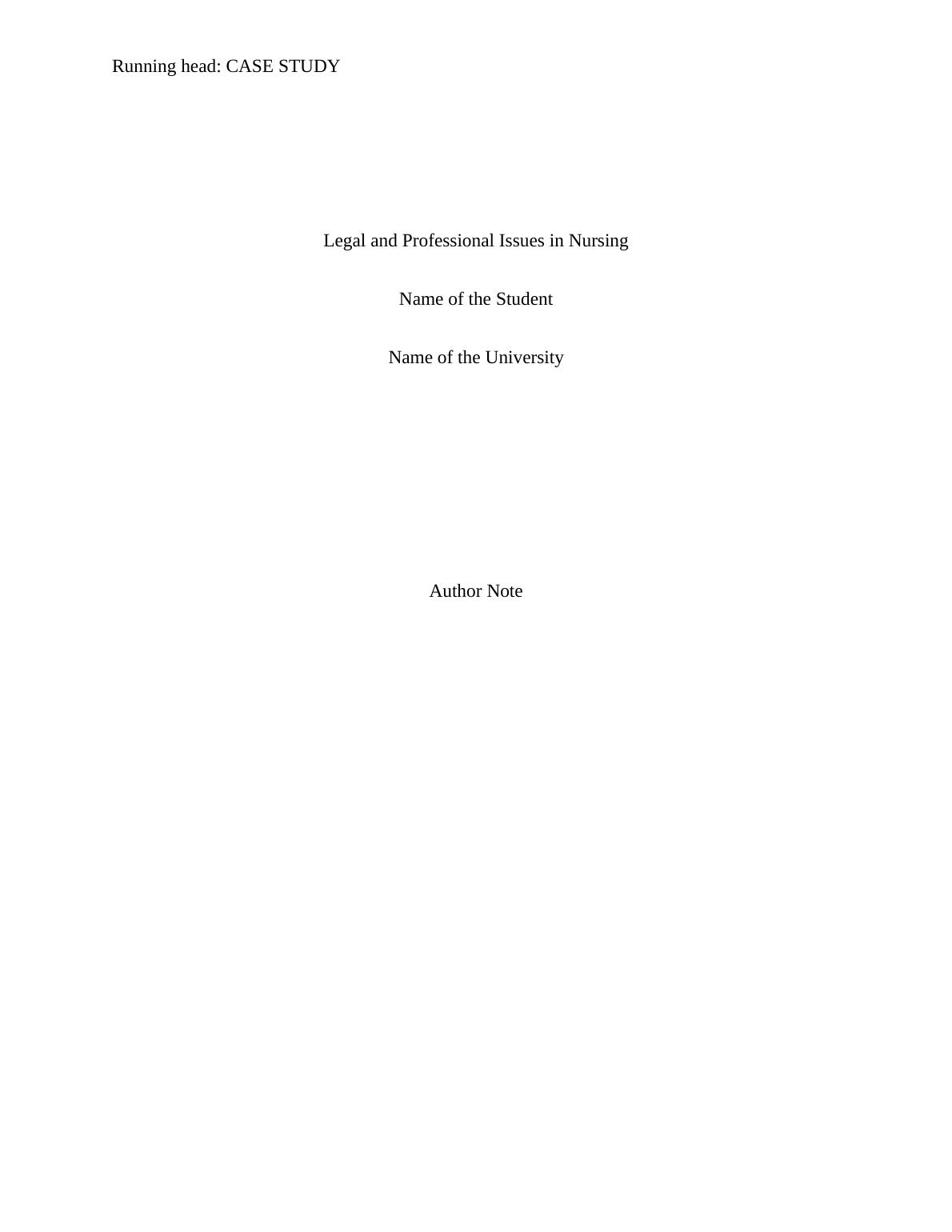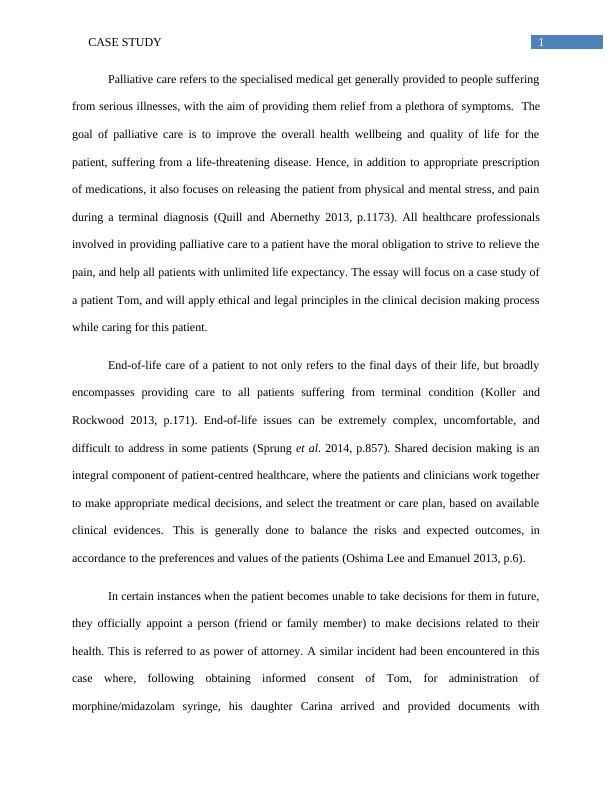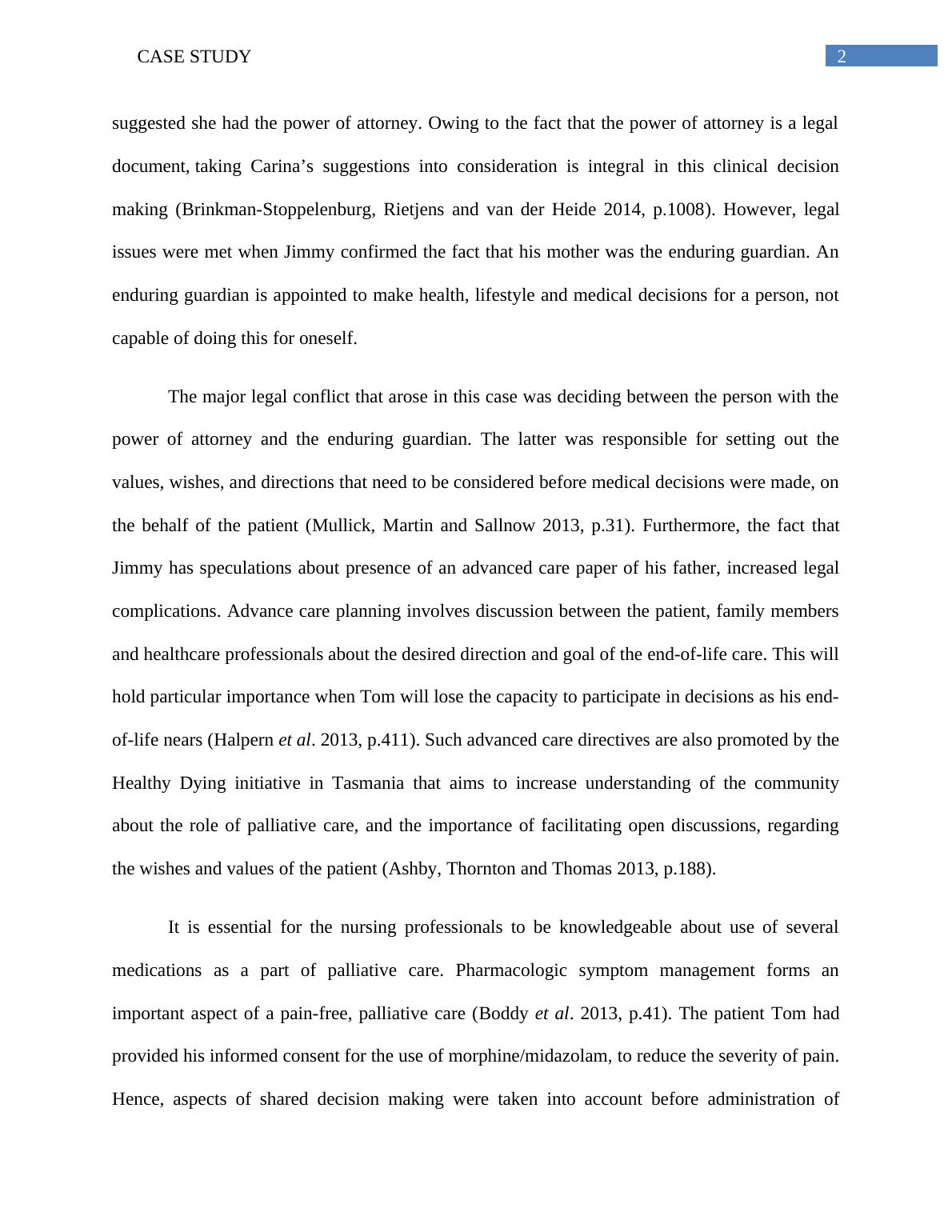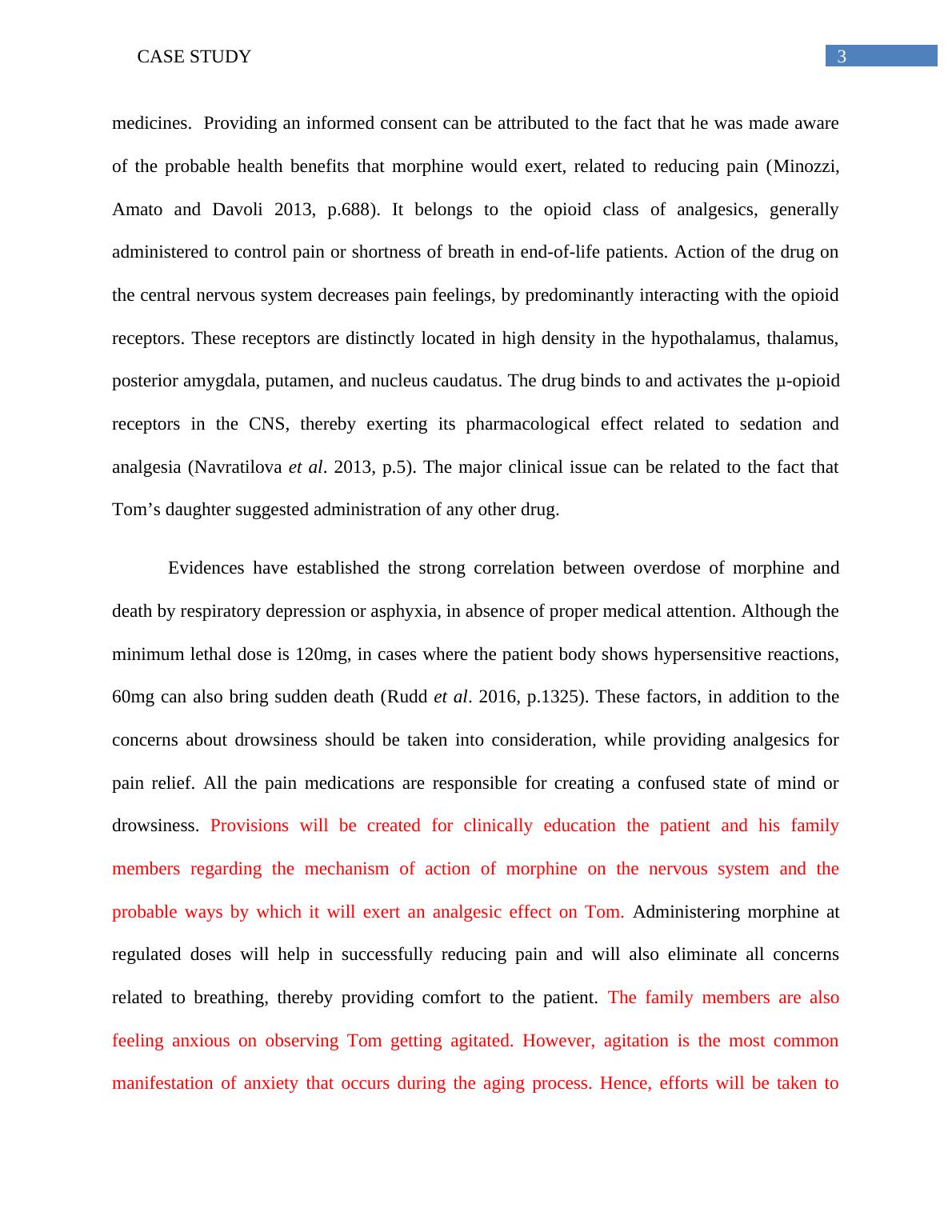Legal and Professional Issues in Nursing: Doc
Added on 2021-05-31
11 Pages2861 Words21 Views
Running head: CASE STUDY
Legal and Professional Issues in Nursing
Name of the Student
Name of the University
Author Note
Legal and Professional Issues in Nursing
Name of the Student
Name of the University
Author Note

1CASE STUDY
Palliative care refers to the specialised medical get generally provided to people suffering
from serious illnesses, with the aim of providing them relief from a plethora of symptoms. The
goal of palliative care is to improve the overall health wellbeing and quality of life for the
patient, suffering from a life-threatening disease. Hence, in addition to appropriate prescription
of medications, it also focuses on releasing the patient from physical and mental stress, and pain
during a terminal diagnosis (Quill and Abernethy 2013, p.1173). All healthcare professionals
involved in providing palliative care to a patient have the moral obligation to strive to relieve the
pain, and help all patients with unlimited life expectancy. The essay will focus on a case study of
a patient Tom, and will apply ethical and legal principles in the clinical decision making process
while caring for this patient.
End-of-life care of a patient to not only refers to the final days of their life, but broadly
encompasses providing care to all patients suffering from terminal condition (Koller and
Rockwood 2013, p.171). End-of-life issues can be extremely complex, uncomfortable, and
difficult to address in some patients (Sprung et al. 2014, p.857). Shared decision making is an
integral component of patient-centred healthcare, where the patients and clinicians work together
to make appropriate medical decisions, and select the treatment or care plan, based on available
clinical evidences. This is generally done to balance the risks and expected outcomes, in
accordance to the preferences and values of the patients (Oshima Lee and Emanuel 2013, p.6).
In certain instances when the patient becomes unable to take decisions for them in future,
they officially appoint a person (friend or family member) to make decisions related to their
health. This is referred to as power of attorney. A similar incident had been encountered in this
case where, following obtaining informed consent of Tom, for administration of
morphine/midazolam syringe, his daughter Carina arrived and provided documents with
Palliative care refers to the specialised medical get generally provided to people suffering
from serious illnesses, with the aim of providing them relief from a plethora of symptoms. The
goal of palliative care is to improve the overall health wellbeing and quality of life for the
patient, suffering from a life-threatening disease. Hence, in addition to appropriate prescription
of medications, it also focuses on releasing the patient from physical and mental stress, and pain
during a terminal diagnosis (Quill and Abernethy 2013, p.1173). All healthcare professionals
involved in providing palliative care to a patient have the moral obligation to strive to relieve the
pain, and help all patients with unlimited life expectancy. The essay will focus on a case study of
a patient Tom, and will apply ethical and legal principles in the clinical decision making process
while caring for this patient.
End-of-life care of a patient to not only refers to the final days of their life, but broadly
encompasses providing care to all patients suffering from terminal condition (Koller and
Rockwood 2013, p.171). End-of-life issues can be extremely complex, uncomfortable, and
difficult to address in some patients (Sprung et al. 2014, p.857). Shared decision making is an
integral component of patient-centred healthcare, where the patients and clinicians work together
to make appropriate medical decisions, and select the treatment or care plan, based on available
clinical evidences. This is generally done to balance the risks and expected outcomes, in
accordance to the preferences and values of the patients (Oshima Lee and Emanuel 2013, p.6).
In certain instances when the patient becomes unable to take decisions for them in future,
they officially appoint a person (friend or family member) to make decisions related to their
health. This is referred to as power of attorney. A similar incident had been encountered in this
case where, following obtaining informed consent of Tom, for administration of
morphine/midazolam syringe, his daughter Carina arrived and provided documents with

2CASE STUDY
suggested she had the power of attorney. Owing to the fact that the power of attorney is a legal
document, taking Carina’s suggestions into consideration is integral in this clinical decision
making (Brinkman-Stoppelenburg, Rietjens and van der Heide 2014, p.1008). However, legal
issues were met when Jimmy confirmed the fact that his mother was the enduring guardian. An
enduring guardian is appointed to make health, lifestyle and medical decisions for a person, not
capable of doing this for oneself.
The major legal conflict that arose in this case was deciding between the person with the
power of attorney and the enduring guardian. The latter was responsible for setting out the
values, wishes, and directions that need to be considered before medical decisions were made, on
the behalf of the patient (Mullick, Martin and Sallnow 2013, p.31). Furthermore, the fact that
Jimmy has speculations about presence of an advanced care paper of his father, increased legal
complications. Advance care planning involves discussion between the patient, family members
and healthcare professionals about the desired direction and goal of the end-of-life care. This will
hold particular importance when Tom will lose the capacity to participate in decisions as his end-
of-life nears (Halpern et al. 2013, p.411). Such advanced care directives are also promoted by the
Healthy Dying initiative in Tasmania that aims to increase understanding of the community
about the role of palliative care, and the importance of facilitating open discussions, regarding
the wishes and values of the patient (Ashby, Thornton and Thomas 2013, p.188).
It is essential for the nursing professionals to be knowledgeable about use of several
medications as a part of palliative care. Pharmacologic symptom management forms an
important aspect of a pain-free, palliative care (Boddy et al. 2013, p.41). The patient Tom had
provided his informed consent for the use of morphine/midazolam, to reduce the severity of pain.
Hence, aspects of shared decision making were taken into account before administration of
suggested she had the power of attorney. Owing to the fact that the power of attorney is a legal
document, taking Carina’s suggestions into consideration is integral in this clinical decision
making (Brinkman-Stoppelenburg, Rietjens and van der Heide 2014, p.1008). However, legal
issues were met when Jimmy confirmed the fact that his mother was the enduring guardian. An
enduring guardian is appointed to make health, lifestyle and medical decisions for a person, not
capable of doing this for oneself.
The major legal conflict that arose in this case was deciding between the person with the
power of attorney and the enduring guardian. The latter was responsible for setting out the
values, wishes, and directions that need to be considered before medical decisions were made, on
the behalf of the patient (Mullick, Martin and Sallnow 2013, p.31). Furthermore, the fact that
Jimmy has speculations about presence of an advanced care paper of his father, increased legal
complications. Advance care planning involves discussion between the patient, family members
and healthcare professionals about the desired direction and goal of the end-of-life care. This will
hold particular importance when Tom will lose the capacity to participate in decisions as his end-
of-life nears (Halpern et al. 2013, p.411). Such advanced care directives are also promoted by the
Healthy Dying initiative in Tasmania that aims to increase understanding of the community
about the role of palliative care, and the importance of facilitating open discussions, regarding
the wishes and values of the patient (Ashby, Thornton and Thomas 2013, p.188).
It is essential for the nursing professionals to be knowledgeable about use of several
medications as a part of palliative care. Pharmacologic symptom management forms an
important aspect of a pain-free, palliative care (Boddy et al. 2013, p.41). The patient Tom had
provided his informed consent for the use of morphine/midazolam, to reduce the severity of pain.
Hence, aspects of shared decision making were taken into account before administration of

3CASE STUDY
medicines. Providing an informed consent can be attributed to the fact that he was made aware
of the probable health benefits that morphine would exert, related to reducing pain (Minozzi,
Amato and Davoli 2013, p.688). It belongs to the opioid class of analgesics, generally
administered to control pain or shortness of breath in end-of-life patients. Action of the drug on
the central nervous system decreases pain feelings, by predominantly interacting with the opioid
receptors. These receptors are distinctly located in high density in the hypothalamus, thalamus,
posterior amygdala, putamen, and nucleus caudatus. The drug binds to and activates the μ-opioid
receptors in the CNS, thereby exerting its pharmacological effect related to sedation and
analgesia (Navratilova et al. 2013, p.5). The major clinical issue can be related to the fact that
Tom’s daughter suggested administration of any other drug.
Evidences have established the strong correlation between overdose of morphine and
death by respiratory depression or asphyxia, in absence of proper medical attention. Although the
minimum lethal dose is 120mg, in cases where the patient body shows hypersensitive reactions,
60mg can also bring sudden death (Rudd et al. 2016, p.1325). These factors, in addition to the
concerns about drowsiness should be taken into consideration, while providing analgesics for
pain relief. All the pain medications are responsible for creating a confused state of mind or
drowsiness. Provisions will be created for clinically education the patient and his family
members regarding the mechanism of action of morphine on the nervous system and the
probable ways by which it will exert an analgesic effect on Tom. Administering morphine at
regulated doses will help in successfully reducing pain and will also eliminate all concerns
related to breathing, thereby providing comfort to the patient. The family members are also
feeling anxious on observing Tom getting agitated. However, agitation is the most common
manifestation of anxiety that occurs during the aging process. Hence, efforts will be taken to
medicines. Providing an informed consent can be attributed to the fact that he was made aware
of the probable health benefits that morphine would exert, related to reducing pain (Minozzi,
Amato and Davoli 2013, p.688). It belongs to the opioid class of analgesics, generally
administered to control pain or shortness of breath in end-of-life patients. Action of the drug on
the central nervous system decreases pain feelings, by predominantly interacting with the opioid
receptors. These receptors are distinctly located in high density in the hypothalamus, thalamus,
posterior amygdala, putamen, and nucleus caudatus. The drug binds to and activates the μ-opioid
receptors in the CNS, thereby exerting its pharmacological effect related to sedation and
analgesia (Navratilova et al. 2013, p.5). The major clinical issue can be related to the fact that
Tom’s daughter suggested administration of any other drug.
Evidences have established the strong correlation between overdose of morphine and
death by respiratory depression or asphyxia, in absence of proper medical attention. Although the
minimum lethal dose is 120mg, in cases where the patient body shows hypersensitive reactions,
60mg can also bring sudden death (Rudd et al. 2016, p.1325). These factors, in addition to the
concerns about drowsiness should be taken into consideration, while providing analgesics for
pain relief. All the pain medications are responsible for creating a confused state of mind or
drowsiness. Provisions will be created for clinically education the patient and his family
members regarding the mechanism of action of morphine on the nervous system and the
probable ways by which it will exert an analgesic effect on Tom. Administering morphine at
regulated doses will help in successfully reducing pain and will also eliminate all concerns
related to breathing, thereby providing comfort to the patient. The family members are also
feeling anxious on observing Tom getting agitated. However, agitation is the most common
manifestation of anxiety that occurs during the aging process. Hence, efforts will be taken to

End of preview
Want to access all the pages? Upload your documents or become a member.
Related Documents
(pdf) Nursing Assignment Samplelg...
|9
|2416
|21
(PDF) End-of-life issues for aboriginal patientslg...
|6
|1593
|232
Communication Issues in Palliative Care: A Case Studylg...
|8
|2110
|2
Palliative Care: Legal and Ethical Principles, Effective Communication, and Care Planlg...
|8
|2386
|343
Assignment on Nursing Caselg...
|7
|1856
|498
Legal and Ethical Principles in Clinical Decision Makinglg...
|9
|2422
|44
